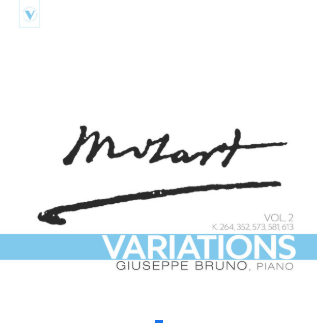Wolfgang Amadeus Mozart’s “Variations on a Theme” are arguably some of the most unique and developed works by Mozart. His interpretation of a simple melody and the interesting ways he changes it make for a fun challenge for pianists trying to emulate his style and a great listen for the casual consumer. Of course, it still comes with the charm and Classical-era style that he has, but it revolutionized composition and brought awareness to pieces people have never heard of.
This is the case with the recently released album “Mozart: Piano Variations, Vol. 2”—performed by Giuseppe Bruno, an Italian pianist and conductor. These variations by Mozart are a two-part series which compiles a subset of piano pieces that aren’t often brought up in Mozart’s repertoire. I often appreciate it when artists utilize their mastery to go through an entire genre of music by certain composers, and this is no exception.
The real charm of this album comes through with Bruno’s interpretation of Mozart’s character. Mozart is often thought of as a joyful spirit: always happy, bright, very Classical, but sometimes impulsive. The dynamics, phrasing, and texture of his compositions must be brought out with clear articulation. This is what makes Mozart, and many other Classical composers, so difficult to play. To play like them, you have to become them.
However, Bruno does an excellent job at interpreting the subtleties of Mozart’s variations, highlighting significant differences between “loud” and “soft” sounds, changes in character, and, of course, bringing out his brilliance. I had never heard these pieces before, but with the way Bruno was playing, I could immediately tell it was Mozart.
By far the most surprising thing about this album was just the sheer amount of “Variations on a Theme” Mozart had written. Most classical musicians are familiar with the “12 Variations on ‘Ah, vous dirai-je maman’”, or perhaps the variations found in the first movement of his “Sonata in A Major, K. 331”. These were the ones that I mainly knew, so I was astounded to discover that he wrote a plethora of these. Some are less impactful than others, but that’s to be expected.
The way Bruno interprets the pieces makes them continuously exciting to listen to. He emphasizes the inventiveness of Mozart’s variations each time and makes them continuously different. Whether it be through texture, dynamic, or tone, he always makes each variation have its own distinct sound. This is the character of Mozart that many classical enthusiasts will be familiar with, and it’s where Bruno’s strengths truly lie.
In short, Giuseppe Bruno’s interpretation of Mozart’s piano variations is nothing short of a masterpiece. The genius ways that he creates the music in Mozart’s image truly highlight the brilliance of the composer and Bruno himself. Pieces like these keep the classical music that we know and love alive, and they continue the legacy of composers all around the world.







